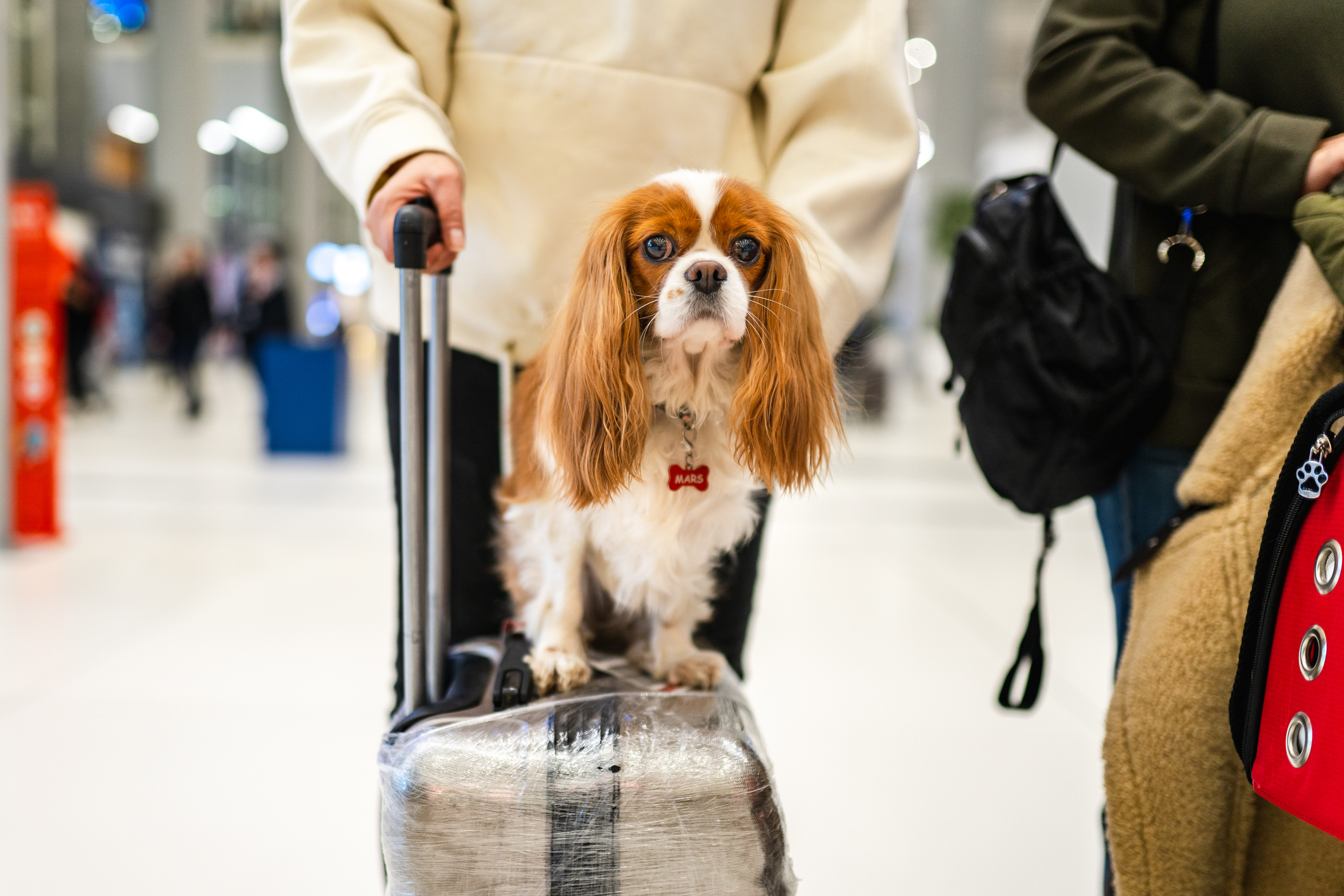Essential Tips for Traveling with Pets: Navigating Airline Policies in 2025
Ensure a seamless journey with your pet by understanding airline regulations and preparation strategies.


Traveling with a pet can be more stressful than traveling with a baby. Each airline seems to have its own set of rules, and depending on the size of your pet, you might not be able to keep an eye on it during the duration of your flight. All of this can lead to unnecessary stress for both you and your pet during your journey, but the best way to combat any stress is to be prepared.
Thousands of people fly every day with their pets successfully and you can too. Here's everything you need to know about getting your pet ready to travel and the multiple airline rules you must follow in order to take your pet on all of your 2025 adventures.
Can your pet fly? Factors to consider before booking
Experts agree: flying isn't just a stressful experience for you, it can be a particularly stressful and jarring experience for your pet. If your pet is prone to anxiety, it can be a good idea to visit the vet before taking flight. They can discuss options, including medication or treats that can help reduce anxiety.
From just $107.88 $24.99 for Kiplinger Personal Finance
Be a smarter, better informed investor.

Sign up for Kiplinger’s Free Newsletters
Profit and prosper with the best of expert advice on investing, taxes, retirement, personal finance and more - straight to your e-mail.
Profit and prosper with the best of expert advice - straight to your e-mail.
Vets can also give you added peace of mind that your pet can physically travel well. If your pet needs to be on any medications, it's a great time to re-evaluate the dosage. Sticking to a medication schedule can be tricky when flying through different time zones, so setting a plan beforehand that aligns with the time zone you're traveling in can eliminate added stress once you've arrived at your destination.
When traveling with brachycephalic (short-nosed) dogs, such as Bulldogs, Pugs and French Bulldogs, it's important to take extra precautions due to their increased risk of respiratory issues during air travel. Their unique facial structure can make them more sensitive to changes in temperature and altitude.
For brachycephalic cats, such as Persians and Himalayans, similar precautions are necessary. While many cats travel in the cabin, reducing some risks, their short-nosed anatomy can still lead to respiratory challenges.
Airline pet travel policies: What you need to know
Here's what you need to know about each major airline's pet travel policy.
United Airlines pet policy
On most United flights, you can bring up to two pets per person and the pet must be a cat or a dog. United does not allow cargo flights for pets unless you're an active duty military personnel or government employee.
There are no weight or breed limitations, but the dog or cat must remain in a carrier for the entire flight and that carrier must be able to fit underneath the seat in front of you. If you're traveling with a second pet, you must purchase an additional seat next to you to slide the carrier under.
Hard-sided carriers that will fit are 9 x 17.5 x 12 inches and soft-sided carriers that will fit are 11 x 18 x 11 inches.
Animals can fly domestically without paperwork, but paperwork needs will vary by the country you are visiting.
Fees: $150 pet fee for each way of travel for domestic flights.
Delta Airlines pet policy
If you're flying on Delta, you can bring a small cat, dog or bird as a carry-on. Pets must be at least eight weeks old for domestic travel, and six months old if traveling to the U.S. from another country. Larger cargo pets cannot currently be shipped on Delta flights unless you're active military personnel or a government employee.
Pets must be able to fit comfortably in a soft-sided kennel that fits under the seat in front of you. Delta recommends soft carriers that measure 18 x 11 x 11 inches.
One pet is allowed per kennel, but two pets of the same breed and size between eight weeks and six months old can travel together in one kennel if they can fit comfortably. A kennel counts as your carry-on item so you won't also be able to bring an overhead bag.
Fees: $125 pet fee for each way of travel for domestic flights.
Southwest Airlines pet policy
Small dogs and cats can fly on Southwest domestic flights. Only one pet carrier per customer is allowed. But two of the same species can be inside one carrier if they both fit comfortably. Cargo shipping a pet is not allowed on Southwest.
Pet carriers must be able to fit in the seat in front of you, and the dimensions allowed include. 17 x 10 x 9.5 inches, or maximum 18.5 x 13.5. 9.5 inches.
Fee: $125 per carrier each way.
American Airlines pet policy
At American Airlines, carry-on pets that are allowed to fly include smaller cats and dogs. Your pet must stay in the carrier the entire flight and the carrier must be able to fit under the seat in front of you. You can bring either a personal item or overhead bin bag with you in addition to the carrier, but not both.
American Airlines is one of the only airlines that allows larger pets to still be shipped via cargo. If you're flying within the U.S., rates are typically $435 each way.
A hard-side kennel must be 19 x 13 x 9 inches if it's a mainland American flight, or 16 x 12 x 8 inches if it's a regional American Eagle flight.
Soft-sided kennels are recommend and must measure maximum 18 x 11 x 11 inches.
Fee: $150 per carrier for each way.
JetBlue pet travel rules
At Jet Blue, no large pets can fly, even through cargo. Only small cats and dogs that can fit in a kennel under the seat in front of you will be accepted.
The kennel counts as one personal item so one other bag can be brought on-board as well.
Hard or soft side kennels are allowed and must not exceed 17 x 12.5 x 8.5 inches.
Fee: $125 per kennel each way.
Cargo flying: Which airlines allow large pets to be transported?
Cargo flying refers to larger pets that cannot fit in a kennel underneath the seat in front of you.
Southwest, United, Delta and Jet Blue do not allow cargo flying larger pets.
Currently, only American and Alaskan airlines allow cargo flights for pets.
Essential steps to acclimate your pet to air travel
When preparing for air travel with your pet, thorough planning is essential to ensure their comfort and safety. Unexpected delays can occur, so pack sufficient food, treats, a collapsible water bowl, waste bags and any necessary medications in your carry-on to accommodate potential overnight stays.
Acclimate your pet to its carrier well in advance by leaving it open in your home, placing familiar bedding inside and encouraging your pet to explore it voluntarily. This familiarity can reduce anxiety during travel. Choose a well-ventilated carrier that allows your pet to stand, turn around and lie down comfortably.
On the day of travel, aim to schedule flights during cooler parts of the day and avoid peak travel times to minimize stress and exposure to extreme temperatures. It's generally recommended to avoid sedating your pet unless specifically advised by your veterinarian, as sedatives can increase the risk of respiratory problems during air travel.
The bottom line
Traveling with your pet requires thorough preparation and adherence to airline policies to ensure a safe and comfortable journey for both you and your companion. By consulting with your veterinarian, acclimating your pet to its carrier and familiarizing yourself with specific airline regulations, you can minimize stress and potential complications during travel.
Remember to pack essential items in your carry-on, such as food, water and any necessary medications, to be prepared for unexpected delays. Staying informed and proactive will help make your 2025 adventures with your pet enjoyable and worry-free.
related content
Profit and prosper with the best of Kiplinger's advice on investing, taxes, retirement, personal finance and much more. Delivered daily. Enter your email in the box and click Sign Me Up.

Brittany Leitner is a freelance journalist with over 10 years of experience in lifestyle, health, and more. She received a Digital Health Award for her reporting in 2019 as well as numerous awards for her work in poetry. She previously held positions as senior editor at Elite Daily and managing editor at The Dr. Oz Show. Follow her online @britariail.
-
 Snowbirds: Avoid These 3 Sneaky Insurance Issues
Snowbirds: Avoid These 3 Sneaky Insurance IssuesBefore snowbirds depart for their winter retreat, they should check their insurance coverage for surprises that might arise, or else be on the hook for repairs.
-
 Hang in There With This Value Fund
Hang in There With This Value FundPatience is required for investors in the Dodge & Cox Stock Fund, but its long-term outperformance proves it's worth the wait.
-
 Snowbirds: Avoid These 3 Sneaky Insurance Issues
Snowbirds: Avoid These 3 Sneaky Insurance IssuesBefore snowbirds depart for their winter retreat, they should check their insurance coverage for surprises that might arise, or else be on the hook for repairs.
-
 I'm a Financial Planner: Here's How to Make the Most of Your Charitable Giving on a Budget
I'm a Financial Planner: Here's How to Make the Most of Your Charitable Giving on a BudgetMaximizing the charitable donations you plan to make this year can help your financial plan stay on track and help give the most to the causes you care about.
-
 5 Ways to Teach Your Kids About Giving Back, From a Financial Planner
5 Ways to Teach Your Kids About Giving Back, From a Financial PlannerTeaching kids generosity goes beyond simple rules and can involve fun, practical strategies, such as letting them lead giving, volunteering together and more.
-
 I'm a Financial Planner: Here's How You Can Use AI to Improve Your Finances
I'm a Financial Planner: Here's How You Can Use AI to Improve Your FinancesApps can help with budgeting, saving and investing, financial coaching and debt management. But providing your personal information can also raise your risks.
-
 How to Get HBO Max for $2.99 with Hulu This Black Friday
How to Get HBO Max for $2.99 with Hulu This Black FridayTake advantage of Hulu’s holiday pricing and stream HBO Max hits for only $2.99 a month.
-
 Hulu’s Black Friday Deal Gets You Starz for Only $2.99
Hulu’s Black Friday Deal Gets You Starz for Only $2.99Get premium entertainment for less with Hulu’s limited-time Black Friday STARZ deal.
-
 The Best Christmas Movies on Paramount+ (and How to Watch Them for Less)
The Best Christmas Movies on Paramount+ (and How to Watch Them for Less)Settle in this holiday season with classic Christmas movies on Paramount+ and save with the service’s limited-time Black Friday deal.
-
 5 Simple Fixes to Save on Heat Bills This Winter
5 Simple Fixes to Save on Heat Bills This WinterWith fuel prices expected to rise 10% or more this winter, making your home more energy efficient will really pay off.